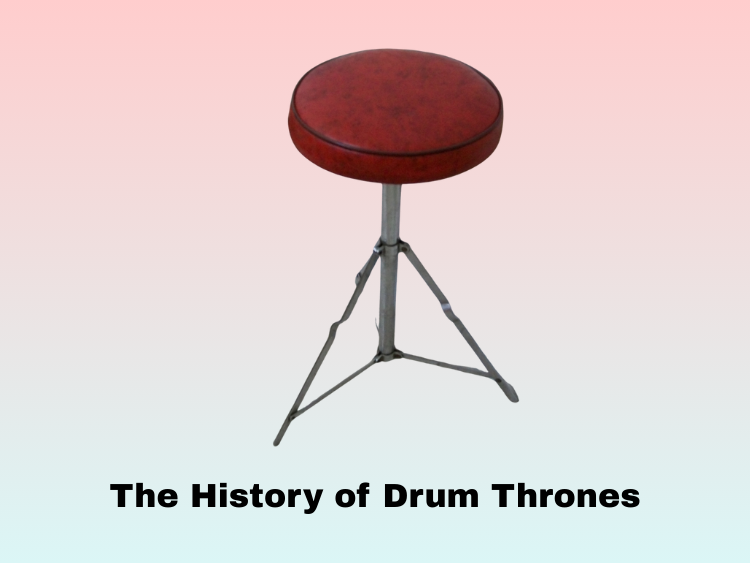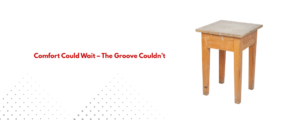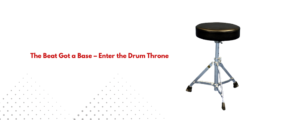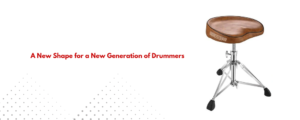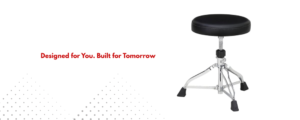People usually talk about drums, cymbals, or new play methods when discussing how music has changed. There is music on the drum, but no sound is heard from the drum chair. At first look, the drum chair might not seem very important, but over time it has become one of the best ways for players to improve their health, performance, and balance. A long time ago, drum thrones were simple chairs made at home. They now have supports that were made to fit a drummer’s body. Comfort is very important for performance.
Early Days: Makeshift Seating (1900s–1930s)
Drum kits weren’t very common in the early 1900s. Although there were no seats for the drums, they used piano benches, wooden stools, or table chairs as needed. Though not very useful or flexible, these short-term fixes worked at a time when jazz and ragtime bands were becoming more popular.
Common characteristics:
- No height adjustment
- No cushioning or back support
- Often unstable on uneven stages
These early seating arrangements forced drummers to adapt to discomfort, often at the expense of posture and endurance. The focus back then was on the drums, not on the drummer’s body.
The First Drum Thrones Appear (1940s–1950s)
As drums became more important in swing and big band music, people needed seats that were more stable and useful. The first drum seats made just for this reason were made during this time. Manufacturers started making padded, round seats with metal tripod legs that held them up.
Notable innovations:
- Round cushioned tops
- Simple tripod bases for better balance
- Manual screw-based height adjustment
These early thrones didn’t offer much in terms of customization, but they introduced the idea that drummers deserved a seat that supported their physical demands on stage.
Expanding Needs with Rock & Roll (1960s–1970s)
The game altered with the 1960s and 1970s boom of rock, funk, and psychedelic music. Drummers were now expected to execute vigorous sets using great force and motion, frequently for hours at a stretch. Seating had to change along with this change.
Key changes:
- More padding to make you feel better
- More stable seats that are wider
- The design folds up for easy transport while traveling.
Still, backrests and advanced ergonomic issues were conspicuously lacking. This was the start of realizing how much a drummer’s sitting position affected their play physically.
The Saddle Revolution (1980s)
The saddle-style drum throne was one of the most striking innovations of the 1980s. These thrones, designed like motorcycle seats, had a curved outline that distributed your weight more evenly and supported your hips.
Important additions:
- Seating in the shape of a saddle to ease pressure on key joints
- Double-braced tripod legs make them last longer
- Memory locks keep your height the same over time
This change showed that people were becoming more concerned about comfort and health when making drum seats. Drummers were fed up with stock seats and wanted custom support to protect their bodies and improve their skills.
Customization and Ergonomics (1990s)
By the 1990s, drum chairs were better made to fit each player. Drummers started picking where to sit based on their own tastes, body types, and playing styles. Custom comfort was now at the heart of chair invention.
Upgrades included:
- Hydraulic methods for changing the height
- More dense foam that is shaped to fit
- Backrests that can be added for extra support
The connection between posture and endurance became clear, especially among drummers performing long studio sessions or extensive live tours.
If you’re curious about how seating comfort changed drumming forever, check out this detailed article on how seat design revolutionized drumming.
Health-Conscious Engineering (2000s)
In the early 2000s, drum thrones were made with a more scientific method. As more musicians were reported to have lower back pain, stiff hips, and circulation problems, companies looked to ergonomics and medical research for help.
Design innovations:
- Stress-relieving zones in memory foam seats
- Split-seat styles that protect the tailbone
- With lumbar support, backrests
- Materials that don’t slip for support while sitting
This decade marked a turning point where drum seats were no longer seen as simple furniture but as crucial components of a drummer’s health and longevity.
Dynamic Motion and Tech Integration (2010s)
The 2010s saw some of the most radical advancements in throne design. As technology advanced, so did the level of responsive support in seating systems.
Emerging features:
- Seats that can turn and move with the drummer
- Posts that absorb shock with hydraulics
- Modular setups with seat bases and tops that can be switched out
- Builds that are light but strong for traveling bands
These features allowed drummers to maintain natural movement patterns, reducing fatigue and enhancing flow. For a deeper dive into recent throne innovations, explore high-tech features you didn’t know you needed.
2020s and Beyond: Tailored Experience and Sustainability
Customization options for drum stools today are unthinkable just a few decades ago. And now drummers can make their own thrones, picking out the shape of the seat, the material, the backrest, the height adjustment, and even the roughness of the airflow.
Modern throne features:
- Memory foam that fits your body
- Fabric that breathes and doesn’t hold sweat
- Long-lasting patterns and eco-friendly materials
- Systems with modular parts
- Smart designs that focused on balancing weight and posture
If you’re comparing options, consider reviewing 2025’s top adjustable drum thrones to see how leading brands are meeting modern demands.
Why Comfort Matters
The history of drum thrones shows how players’ relationships with their instruments have changed over time. A chair that was well made:
- Lessens strain and tiredness
- Helps keep the spine and pelvis in place
- Makes control and response better
- Protects against pain and increases the ability to life
On the other hand, not having enough seats can hurt players physically and even force them to cut back or quit altogether.
Final Thoughts
Over the history of drum thrones, from simple wooden chairs to more complicated curved platforms, there have been small changes that have made them more comfortable for players. As performance expectations grew and new types of music emerged, it became important to have physical support and comfort.
People today think of the throne as an important part of the drum set, just like good snares and cymbals. Comfort is a must for playing music for long amounts of time, being creative, and playing for a long time.

